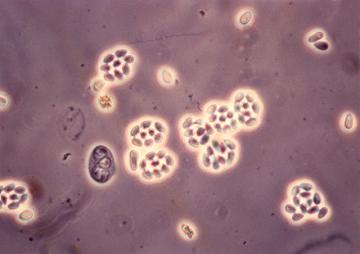Dampening the Spread of Fire Ants

Spores of the microsporidian pathogen Kneallhazia solenopsae, a potential biocontrol of fire ants. (Photo by David Oi)
Imported fire ants are a related group of ants commonly known for their painful stings affecting humans and animals. They were first introduced in the United States in the 1930s from South America, their native range. In South America, there are more than 60 pathogens and parasites in the environment that are natural enemies of these ants. In contrast, in the United States, there are only about eight. This disparity and other factors have allowed the fire ant to spread widely in the southern tier of the U.S., where they are a harmful pest to humans, animals, agriculture, and the environment.
To control the amount of fire ants in the environment, ARS researchers are working on biocontrol methods that suppress the ants and make them less competitive with other, local ant species. Usually, the main control for fire ants are fire ant baits. This control method works by having foraging ants gather the bait and transporting it back to their colony. Once the bait is consumed, its active ingredients spread throughout the entire colony, resulting in the death of worker ants, larvae, and even the queen.
“We have one study out where we show that you can control the ants with toxic baits, (and) you can eliminate them from an area, but then the fire ants will reinfest the same area because they readily move in from surrounding areas, and mating flights produce huge numbers of potential new queens that can develop into new colonies,” explained David Oi, a research entomologist at ARS’s Imported Fire Ant and Household Insects Research Unit (IFAHIRU) in Gainesville, FL.
Insecticides must be applied frequently to maintain control, Oi said. However, with different biocontrol methods like pathogens and parasites, there can be sustained pressure on these pest ants. For this reason, researchers are working with three primary biocontrol methods: species of parasitic flies and two pathogens, a microsporidium and a virus.
The virus is called Solenopsis invicta virus 3 and it reduces survival and fecundity in infected ants. The microsporidium, called Kneallhazia solenopsae, is a pathogen that causes the slow demise of a fire ant colony by producing spores that inject their contents into the cells of the ants that ingest them. Infected queens lay less eggs and die prematurely.
The flies are specific parasites of fire ants that kill their host in the end. The flies lay eggs inside of the worker fire ants; the egg then hatch into a maggot that travels through the body of the ant, eventually ending up at the head where it matures. There, the flies release enzymes that cause the ants’ heads and other body parts to fall off. Unfortunately, Oi explained that this method is not very effective; it is estimated that worker numbers in a fire ant colony are reduced by up to 15%, but the colony lives on. There are flies that attack ants that leave their colony to find food or are involved in a mating flight. When worker ants detect the presence of the flies they often stop what they are doing and seek refuge in their colony.
“The idea here is we're trying to layer on different biocontrol agents to help suppress the ants,” explained Oi, “so, the virus is acting one way (and) the microsporidia are acting another way.”
Fire ants can affect human health with their painful stings, to which many people are allergic. They also disturb other animals and other ant communities. Fire ants can accidently move into electrical transformers or switch boxes and cause short circuits. In agriculture, they attack crop seedlings during germination, and they can sting livestock and cause health issues, particularly in newborn calves where stings to their eyes often cause blindness.
“Our objective is to identify and release safely as many fire ant specific pathogens and parasites as possible into the United States population to have a cumulative effect and reduce fire ant population levels,” explained Steven Valles, a research entomologist at the IFAHIRU.
Working together, these different methods of biocontrol will help achieve an environment in which the fire ants have natural enemies that can contain or reduce their population. — By Olga Vicente, ARS’s Office of Communications.
Also in our series on fire ants:

